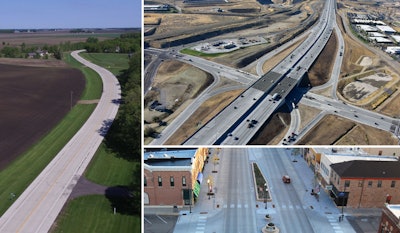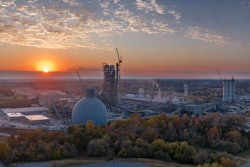
With the start of World of Concrete 2023, the American Concrete Pavement Association released a white paper compiling research around how concrete pavement is uniquely suited for building road surfaces that not only last longer, but reduce carbon footprint, ease vehicle fuel consumption and substantially increase payback in the long-run.
The white paper, titled “Concrete Pavement’s Role in a Sustainable, Resilient Future,” is available as a free download on the ACPA website here. As the title suggests, the paper’s focus is positioning concrete as the best material to meet sustainability goals for pavements the world over.
The paper defines sustainability as the “capacity to maintain a process or state of being into perpetuity, without exhausting the resources upon which it depends nor degrading the environment in which it operates.” Striking that balance is a tall order, but that’s really the point of the whole paper.
The paper argues that the key to concrete’s unique sustainability proposition are its strength, durability, and load distribution. In other words, the paper argues that concrete’s resiliency is second to no other material.
“Unlike sustainability, resiliency deals with unknown events that have high negative impacts like loss due to flood, earthquake, etc.,” the paper reads. “In a changing climate where extreme weather events are greater in frequency and intensity than in the past, it is impossible to have sustainable infrastructure without resilience. A truly sustainable system must incorporate resilience to ensure that these disruptive events will have as little impact as possible and will not significantly increase the need for additional future rehabilitation and reconstruction activities.”
Roadmap to Carbon Neutrality
The ACPA paper also details the concrete industry’s roadmap to carbon neutrality as defined by the Portland Cement Association (PCA). The industry has committed to achieving carbon neutrality by 2050 and the ACPA paper argues that while focus on reducing carbon emissions during the production of concrete is vital to carbon neutrality efforts, reaching the 2050 goal will require a holistic approach and optimization of the entire value chain:
- The production of clinker, the key chemically reactive ingredient used to produce cement.
- The manufacture and shipment of cement, which binds a concrete mixture together.
- The production of concrete by mixing cement with other ingredients (primarily aggregates and water).
- Construction of the built environment, including concrete pavements.
- Carbonation, where concrete structures absorb CO2.
To achieve optimization across these five stages of the value chain, the paper argues for accountability at each stage and for communication and collaboration toward the goal between stakeholders at each stage.
Lifecycle Design Approach
Extending on the idea of a holistic approach to sustainability, the paper also argues for the importance of focusing not only on each stage of the value chain but each stage of a pavement’s life:
- materials production
- pavement design
- construction
- use stage
- maintenance and preservation
- end-of-life
The paper argues for a re-thinking of the design phase for pavements, with an emphasis on designing pavements to last more than 50 years. The research concedes that this optimized approach to designing long-life pavements comes at a higher upfront cost. However, the paper forecasts substantially higher payback throughout the use phase of the pavement—a key point because the pavement will last much longer by design.
Improving Concrete Mixtures
The paper calls for the continued exploration of Performance Engineered Mixtures (PEMs). These mixtures are optimized to reduce the amount of cement that goes into concrete and fill in the gaps with other materials that will reduce the up-front burden of concrete production’s high CO2 footprint.
The paper advocates for these mixes to implement more Portland Limestone Cements, saying that research shows that PLCs lower CO2 impacts by an additional 10%.
Another recommendation is for designing pavements to be easier on cars. Specifically, to engineer mixes that grab tires, which increases friction and lowers fuel efficiency.
The paper also points out the importance of pavement albedo, the measure of solar energy reflected by a surface. In short, the higher the albedo, the better a pavement reflects heat rather than absorbing it.
The absorption of heat by pavements is a major contributor to urban heat island impacts. Concrete is much cooler than asphalt to begin with, and ACPA is arguing for increasing its reflective capabilities as a low-cost, low-risk way of addressing climate change.
You can read more in the full paper from the ACPA, here.
















![Fcp Racatac Chair 10893876[1]](https://img.forconstructionpros.com/mindful/acbm/workspaces/default/uploads/2025/10/fcp-racatac-chair-108938761.10l0At5WXv.png?ar=16%3A9&auto=format%2Ccompress&bg=fff&fill-color=fff&fit=fill&h=135&q=70&w=240)



